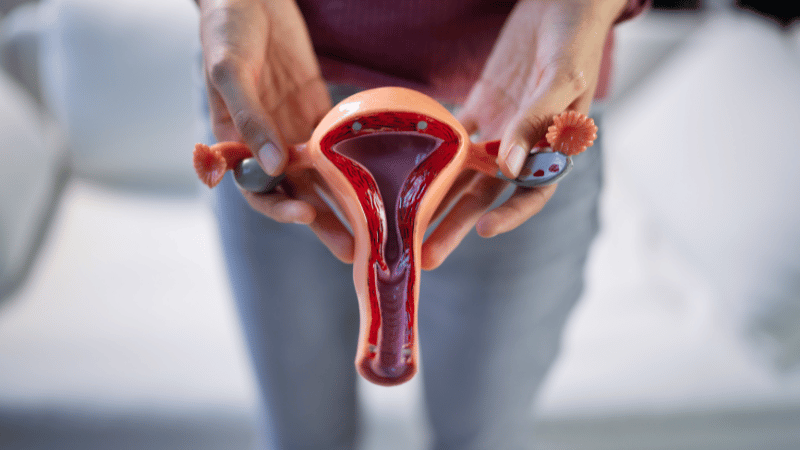
Pink discharge — a small amount of blood mixed with your normal vaginal discharge —can have several causes, including hormonal changes, infections, vaginal irritation, or even early pregnancy. While pink discharge is not always a cause for alarm, it’s important to identify the underlying reason, especially if you are already managing or concerned about fibroids.
For women with fibroids, pink discharge can sometimes be a related symptom. If you are experiencing other common fibroid symptoms, like abdominal pain and abnormally long and heavy periods, it’s advisable to consult with a fibroid specialist. At USA Fibroid Centers, our interventional radiologists can help you determine if fibroids are causing your symptoms.
Schedule Your Consultation Today
What Does Pink Discharge Mean?
Pink spotting during your period often results from light bleeding mixed with cervical mucus, which can give it a pink hue. Understanding cervical mucus can help you better understand changes in your discharge.
The Role of Cervical Mucus
Cervical mucus changes consistency throughout menstruation in response to hormonal fluctuations. It protects the reproductive tract from infections, helps sperm move during ovulation, and forms a thick mucus plug to prevent bacteria from entering the uterus during pregnancy.
Different Discharge Colors
It’s important to know what different colors and textures of discharge mean.
- Pink: Pink discharge is usually a mix of blood and cervical mucus caused by light bleeding during a period.
- White: White discharge is most commonly detected at the beginning and end of a menstrual cycle, but if it’s accompanied by itching, it can be a sign of a yeast infection.
- Clear: Clear discharge can be either watery or stretchy and sticky. Watery discharge can occur at various times, especially after exercise. Stretchy clear discharge is considered a sign of ovulation and usually occurs mid-cycle.
- Yellow/Green: If you notice a clumpy yellow or green discharge at any phase of the menstrual cycle, it may be a sign of infection.
- Brown: Brown discharge commonly occurs at the end of your period due to old blood exiting the uterus.
While some color variations are expected, a healthcare professional can help provide appropriate guidance if you notice vaginal discharge color changes.
Common Causes of Pink Vaginal Discharge
While pink vaginal discharge may be a regular part of your menstrual cycle, it can also result from conditions requiring medical attention. Understanding the causes can help determine when to seek a proper diagnosis and treatment plan.
Fibroids
Fibroids, specifically submucosal fibroids within the uterine cavity or endometrial lining, put pressure on the uterine lining, causing small blood vessels to rupture. This results in light bleeding or spotting, leading to pink discharge.
While fibroids do not produce discharge, they can contribute to changes in vaginal discharge, resulting in watery or blood-tinged discharge. By age 50, 85% of women are affected by fibroids, and ignoring symptoms can lead to conditions like anemia.
What Color is Fibroid-Related Vaginal Discharge?
Fibroids can cause heavier or prolonged menstrual bleeding or bleeding between periods. When this blood mixes with normal vaginal discharge, it can change colors, such as:
- Pink: Fresh blood mixed with discharge.
- Red: Results from heavier bleeding that mixes into the discharge.
- Brown: Older blood is exposed to oxygen that mixes with the discharge.
Treatments like uterine fibroid embolization (UFE) can help manage fibroid bleeding without the risks of surgical procedures. This minimally invasive procedure blocks the fibroids’ blood supply, shrinking them and alleviating symptoms.
Learn More About UFE Treatment
Hormonal Imbalances
Hormonal imbalances often occur due to changes in birth control, perimenopause, or ovulation. Birth control methods, particularly those involving hormonal contraception, can cause estrogen and progesterone levels to fluctuate, leading to light spotting or pink discharge as the body adjusts.
During ovulation, a natural hormonal surge can result in minor bleeding mixed with cervical mucus. Similarly, perimenopause, the transitional phase before menopause, is characterized by hormonal shifts that may cause irregular bleeding or spotting, including pink discharge.
Infections and Irritations
Pink vaginal discharge can result from infections or physical irritations disrupting the vaginal environment or causing minor bleeding, including bacterial vaginosis (BV) and yeast infections. A fishy odor or vaginal discomfort often accompanies BV, while yeast infections cause discoloration due to irritation of the vaginal walls.
Additionally, certain sexually transmitted infections (STIs) like chlamydia or gonorrhea may lead to pink discharge, accompanied by symptoms like pelvic pain, painful urination, or discomfort during intercourse.
Physical irritations, like minor tears or irritation during sexual activity, can also cause pink discharge, especially if the vaginal tissue is sensitive or dry. Similarly, a pelvic exam or Pap smear may cause light spotting due to disruptions to the cervix or vaginal lining.
Other Potential Causes of Pink Vaginal Discharge
While light pink discharge is often associated with menstrual changes, pregnancy, or hormonal shifts, it can also result from other conditions, including:
- Endometriosis: Where tissue similar to the uterine lining grows outside the uterus.
- Cervical Polyps: Small, benign growths on the cervix that can cause light spotting or pink discharge, especially after sexual activity or a pelvic exam.
- Cervical Cancer: Though rare, cervical cancer can sometimes present as light pink spotting. Symptoms may include watery discharge, irregular bleeding, or pain and bleeding during or after sex.
Consult a healthcare provider if the pink discharge is persistent or unexplained, especially if combined with other symptoms. Early evaluation helps rule out severe conditions and ensures timely treatment.
Understanding Pink Discharge Before vs. After Periods
Pink discharge before or after periods occurs when light bleeding mixes with vaginal fluid, creating a diluted pink appearance. Irregular periods, such as very light or mid-cycle breakthrough bleeding, may also cause pink discharge.
Pink Discharge Before Period
Pink discharge before a period is often caused by hormonal fluctuations or implantation spotting, specifically with shifts in estrogen and progesterone levels. This light pink spotting is generally harmless and may occur in the days before a period.
Pink Discharge After Period
Pink discharge after a period is typically from leftover menstrual blood mixing with cervical fluid. As the menstrual cycle ends, small amounts of residual blood may remain in the uterus, gradually expelling itself and mixing with normal vaginal secretions to cause light pink spotting. This process is normal as your body clears the uterine lining.
Pink Discharge During Pregnancy
Pink discharge during pregnancy can have various causes, many of which are not overly concerning. Implantation bleeding is when fertilized eggs attach to the uterine lining and is typical early in pregnancy. Increased blood flow and hormonal changes can also lead to light pink spotting.
However, if there are additional symptoms, such as heavy bleeding, a foul odor, or severe cramping, seek immediate medical attention, as during the first trimester, this can sometimes be a sign of a miscarriage.
How to Track Pink Discharge Patterns
Tracking light pink discharge using a symptom diary or cycle-tracking app can provide valuable insights into your health and help identify potential causes. You can note the timing, color, and patterns of your discharge and any symptoms like cramps, unusual odors, or irregular bleeding. Diligent tracking provides detailed information to aid fibroid specialists in accurately diagnosing and determining treatment.
When to Seek Medical Advice
If you’re experiencing persistent pink vaginal discharge alongside other symptoms, seek medical advice, as it can be a sign of conditions like fibroids. UFE treatment at USA Fibroid Centers can shrink fibroids without surgery to help alleviate symptoms.
Consulting a healthcare professional can prevent potential complications so you receive an accurate diagnosis and treatment. Schedule a consultation with our fibroid specialists online or by calling 855.615.2555.
FAQs
Why Is My Discharge Pink Without a Period?
Light pink discharge outside of a period often results from a small amount of blood mixing with normal vaginal secretions. Common causes include ovulation spotting, implantation bleeding, hormonal imbalances, uterine fibroids, and sexually transmitted infections like chlamydia or gonorrhea.
How Can I Tell if My Pink Discharge is Normal or Concerning?
Whether pink discharge is normal depends on its timing, consistency, and accompanying symptoms. It can typically occur at the beginning or end of your period or after starting new hormonal birth control. Normal pink discharge is usually light, without a foul odor, pain, or fever.
However, persistent pink discharge between periods, during pregnancy, or after menopause can be concerning. Consult a doctor if there are significant changes in discharge consistency, such as clumpiness or unusual textures.
Can Stress Cause Pink Discharge?
While stress can contribute to a light pink discharge by disrupting hormonal balance, leading to changes in menstruation, it is rarely the sole cause. Other factors are more likely, such as infection, pregnancy, or fibroids.
While pink discharge is often short-term and linked to factors like ovulation or the start of your period, persistent pink discharge accompanied by abdominal pain, nausea, or a foul odor warrants a visit to a medical professional, such as a fibroid specialist.







